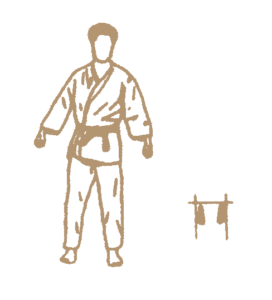This is the first stance you'll ever learn within Shotokan Karate, and it's the position from which you will most often practice your basics. It's also known as ready stance, implying alert readiness. Whilst it's not taught as a true combat stance, it could be argued that it's the position that you're most likely to start any real-world confrontations, which is to say that you'll be standing in a natural, non-confrontational posture.
It's considered to be just as important as all the other stances - after all, you'll be spending a lot of time standing in this position! The position of the feet in parallel stance is all-important because it creates tension in the muscles of the lower half of the body, and that in turn translates into better rotational power when practicing your hip-work.
You would be unlikely to adopt this stance in combat as it's defensively weak from every angle. However, you can deliver more techniques from this stance, without adjusting your position, than from any other stance.
Because it has a high centre of gravity, it's not particularly stable, although the inward tilt of the feet does help to root you somewhat. However, the compensation for any lack in stability, is fast mobility - it's easy to move explosively in any direction from this stance. You can move backwards quickly; you can side-step; you can move forwards; you can block, strike or kick.
The usual accompanying arm position is used as an exercise to practice keeping your elbows in, and to develop your forearms and straight wrist shape.
Some people suggest that this stance is a more stable ready position to adopt than with the toes turned outwards. We seem to be one of the few martial arts clubs that holds this belief. Against a frontal attack, having a wider base at the back does give it a tiny bit of additional stability, but as I've already mentioned, this is not a stance from which you would fight as it's too vulnerable.
In actual fact, no other stance, better enables you to engage your hips on both sides better than this one. Just try turning your toes out or straightening your legs to see how much less rotation you get...
Technique:
| # | Description |
|---|---|
| 1. | As its name indicates, this is a parallel stance. which means that neither foot is forward of the other and your weight is balanced evenly between them. Your feet should be about one shoulder-width apart, and that should feel like a fairly natural width. Your toes are turned slightly inward, pressing against the floor to provide the traction for any hip rotation you may require as you deliver techniques, or for subsequent foot movement as you move into a different stance. |
| 2. | Your knees should be slightly bent. Opinions vary over whether your knees should press outwards, inwards or remain neutral. Outwards increases tension, but reduces rotational mobility. Inwards, increases mobility but reduces tension and strength. Outwards looks a little cooler, but I prefer to choose the middle way and leave my knees in their natural posture! |
| 3. | Your back should be straight and natural, and your hips and shoulders should face forwards in their natural position. Having said that, many people say that you should tuck your hips under, (which is achieved by clenching your butt cheeks and rolling your groin upwards). This supposedly provides better lower-body tension, and it's definitely less-painful if you suffer from back problems. However, as Shotokan's sensei Phil Redmond points out, over time, hip tucking straightens the curvature at the bottom of the spine, eliminating a valuable source of suspension and decreasing its dynamic response. |
| 4. | If you are not delivering techniques (for example, when your sensei is talking), your arms also have a correct position in the full Heiko Dachi stance. They should be held out, about a fist distance in front of your thighs, and just wide enough apart so that if you swing them backwards past your legs, your knuckles brush against the outside of your legs. Your elbows should be slightly bent, and your fists should be clenched. Your palms should face towards each other. |
Common mistakes to avoid
- Make sure that the outside edges of the feet face straight fowards, which makes it look as though the toes are facing inwards. Do not actually turn your toes in or out.
- Do not forget to bend the knees. This adds suspension to your stance, making it easier to retain balance, and gain power.
- Keep your elbows tucked in by your sides. If you let them stick out, you look like a gorilla or have chicken wings.
- Remember, your fists should be in a wheelbarrow lifting position. Anything else makes you look you are riding a motorcycle.

Attitude of readiness with feet parallel.





